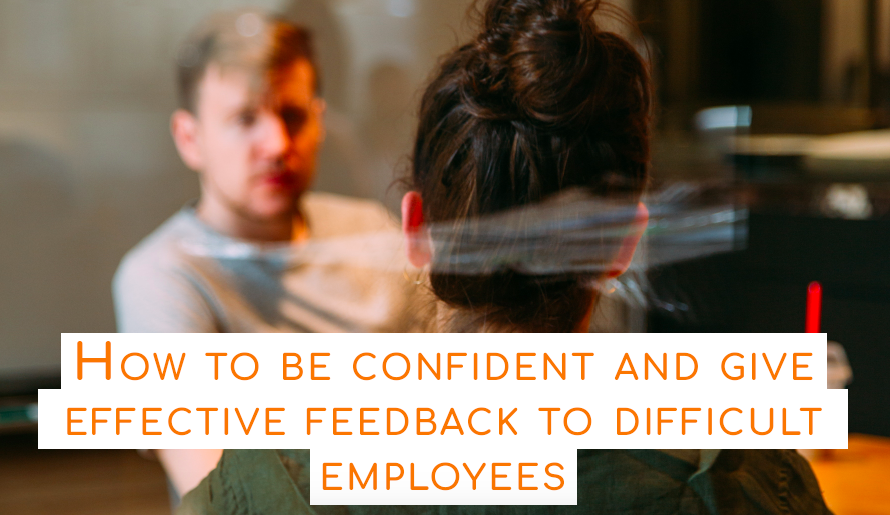Would you like to be be more confident when you deliver feedback?
Or do you work with a difficult employee who you dread giving feedback to?
Most people are not naturally good at giving feedback – myself included, and that’s why I can now confidently say that it’s a skill you can teach yourself. In fact, it’s one of the most useful skills I’ve ever learned!
I’ll teach you the method I also teach my clients, and which I have used countless time with difficult people – confidently and with minimal friction.
Whether you have to give regular feedback to a difficult employee, or need to give feedback from time to time, this methods works.
Timing
Timing is key – you should wait until you’ve got a private moment with the other person, and make sure you’re calm, collected and have mentally rehearsed what you want to say. However a big mistake I see people make is to wait for too long until finally giving the feedback.
If at all possible, you should give it the same day – any longer, and the significance and impact of the event will diminish for both of you. For very heated discussions, it’s okay to schedule ithe feedback for the next day until you both have cooled down.
Step 1: Start with a question
It’s a huge advantage if you can approach the conversation with the difficult employee with a sense of curiosity. Rather than starting off by stating the issue, instead, start with a question:
“How do you think it went?” or “Talk to me, what went well and what could have gone better?”
You will be surprised just how self-aware most people are. By doing this, not only do you ‘soften up the blow’ of what is to come, but you often end up halfways where you wanted to take the conversation to in the first place. You’ll also get to know exactly what they know of the situation, so you can add the missing bits later.
In the case of a very difficult employee, they might not open up about what went bad, so here you should make use of step 4.
Step 2: Practise being non-judgmental and empathic
Always approach the conversation in the knowledge that there are usually two sides to any story. No matter how obvious the mistake or shortcoming of the employee, get your mental state into a mode of empathy, and be open to hear their version of events without judging them.
I know this can be challenging with ‘repeat offenders’, but it’s still a very useful and mature habit to adopt. Until you hear the story directly from them, you simply don’t have the full picture.
This is a skill that can be trained by doing mindfulness exercises, and which comes in massively handy in your personal life too.
“People will remember how you made them feel more than any words you say”
Step 3: State the positives
Be sure to acknowledge the good work the employee has demonstrated. Depending on the situation, it can be useful to kick off the conversation by stating this. Doing this lightens the mood and makes the employee feel appreciated and more at ease.
Step 4: Be clear and specific in your feedback
Difficult employees often use lack of clarity and specificity on the issue to shift blame in an evaluation process later on, so in order to avoid this, you need to express yourself as clearly and specifically as possible.
Give as much relevant and practical detail about the offending behaviour and the impact it had on the company.
Be careful to not use words such as ‘always’ or ‘never’, as they’re usually an overgeneralization and might lead to the employee becoming defensive.
Rehearsing what you are going to say in a mirror beforehand is a useful trick, as it ensures your delivery is smooth, confident and complete.
Step 5: Comment on the behaviour, not the person
Be careful not to relate your feedback to the employee personally. And definitely don’t go into psychoanalysis mode, where you try to understand the motivations behind their behaviour, because chances are you’re probably wrong.
Instead, focus on the behaviour of the person, and the impact their shortcoming has on you, other employees and the company as a whole. You might also want to mention the impact on the employees’ own career progression if relevant.
it’s very important to be super clear on the consequences of them not addressing the issue as discussed.
Step 6: Listen
Listening is such an underused skill.
Throughout the conversation, make sure you listen intently to what the other person has to say. Even if you feel sure and confident about your case, stay open-minded as you never know what new information might come to light.
Step 7: Elaborate and speak slowly
Based on what new information they bring to the table after you’ve given the feedback and listened to them, you should now throw the ball back at them with whatever information and viewpoint you hold.
Mastering this stage relies heavily on confidence, which again, comes from practise. So remain calm and collected, and think before you speak.
A statement, spoken slowly, that comes after a 5 second pause carries a much heavier weight than the same statement uttered quickly and immediately.
Practise speaking slowly.
Step 8: Empower
Especially with a difficult employee, it’s important to let them choose the new behaviour (the way forward) for how they will achieve the desired new situation (the solution).
Ask them what specifically they themselves suggest they could do differently. By doing this you also empower them and make them feel valued.
Step 9: Collaborate
As much a you can, build on their ideas. Don’t be afraid to voice that you love this idea, and ‘what about adding xyz’. Suggest it rather than dictate it though.
Consider sharing past experiences from your own life to demonstrate what has worked for you in a similar situation.
Showing vulnerability makes you come across as more credible. It creates trust and a shared bond between you.
Step 10: Give space
This is another powerful habit for you to adopt, related to the virtue of speaking slowly.
Give the person space. Practise being comfortable with silences while you stay firm. Stop talking, hold eye contact and let them speak.
It’s important that you don’t get wound up in emotions embedded in the employee’s reaction. Stand your ground, speak slowly and be comfortable with the silence. The last thing you want is to water down everything you’ve said and thereby creating confusion and irritation.
Step 11: Conclude and document
Summarise what you’ve agreed on together, and make it clear that you are holding the employee accountable to their improved behaviours.
Set a time and date for the next meeting, where you once again check in and assess whether the employee has taken onboard the feedback.
Conclusion
Giving feedback is hard, but by following these steps you now have a method to make the whole experience more pain-free and effective for everyone involved.
Remember it’s also about practise, so don’t discount the value of rehearsing what you are going to say.
It’s also crucial to adopt the mindset of empathy and listening, as well as the habits of speaking slowly and being comfortable with silences.
If you feel you’re particularly in need of developing any of these, use mindfulness exercises to embed them until they become second nature.
PS: Do you have a favourite tip that helped you become better at giving feedback? Do share it 🙂








Leave A Comment